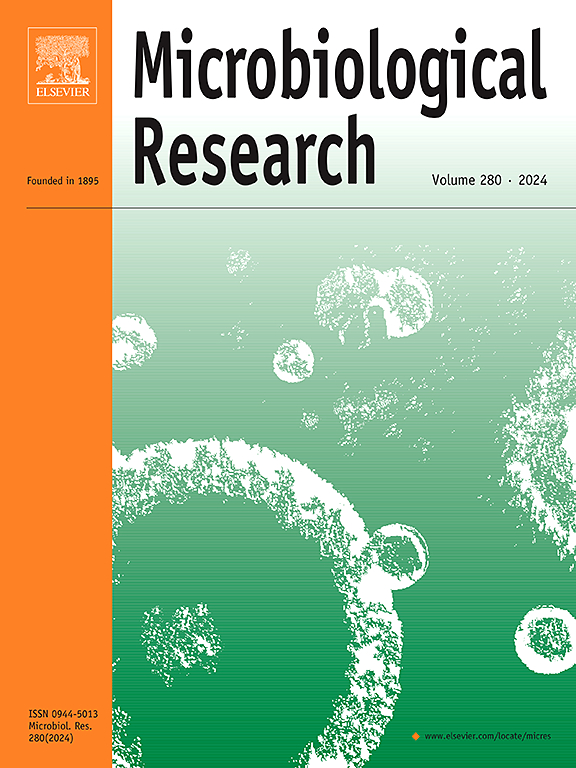Fusarium oxysporum NAD+ hydrolase FonNADase1 is essential for pathogenicity and inhibits plant immune responses
IF 6.1
1区 生物学
Q1 MICROBIOLOGY
引用次数: 0
Abstract
Plants use nicotinamide adenine dinucleotide (NAD+) as a key signaling molecule to activate immune responses. However, whether pathogens secrete specific NAD+ hydrolases (NADases) to affect plant NAD+ levels for infection remains unclear. Here, we report the function and possible mechanism of fungal NADases in watermelon Fusarium wilt fungus Fusarium oxysporum f. sp. niveum (Fon) pathogenicity. Fon secretes two NADases, FonNADase1 and FonNADase2, both of which harbor a secretory signal peptide and an NADase-active tuberculosis necrotizing toxin (TNT) domain. FonNADase1 and FonNADase2 are not involved in the growth, development, or stress responses of Fon. Moreover, only FonNADase1 is essential for Fon pathogenicity, and FonNADase1 deletion results in decreased invasive growth and spread within watermelon plants. FonNADase1 and FonNADase2 are functional NADases capable of decreasing plant NAD+ levels and FonNADase1 inhibits INF1- and BAX-induced cell death and chitin-triggered immune responses in Nicotiana benthamiana leaves in an NADase activity-dependent manner. Furthermore, FonNADase1 inhibited INF1- and BAX-induced expression of defense genes, such as NbPR1a, NbPR2, NbLOX, NbERF1, NbHIN1, and NbHSR203J, in N. benthamiana leaves and affected the expression of a set of immunity-associated genes in watermelon plants. These findings suggest that FonNADase1 plays a key role in Fon pathogenicity by affecting fungal invasive growth and spread within plants as well as modulating host immune responses, thus highlighting the critical role of fungal NADases in pathogenicity.
尖孢镰刀菌NAD+水解酶FonNADase1在致病性和抑制植物免疫应答中起重要作用
植物利用烟酰胺腺嘌呤二核苷酸(NAD+)作为激活免疫应答的关键信号分子。然而,病原体是否分泌特异性的NAD+水解酶(nadase)来影响植物NAD+水平以感染尚不清楚。本文报道了nadase在西瓜枯萎病真菌Fusarium oxysporum f. sp. niveum (Fon)致病性中的作用及其可能机制。Fon分泌两种nadase, FonNADase1和FonNADase2,它们都含有分泌信号肽和nadase活性结核坏死毒素(TNT)结构域。FonNADase1和FonNADase2不参与Fon的生长、发育或应激反应。此外,只有FonNADase1是Fon致病性所必需的,FonNADase1的缺失导致Fon在西瓜植株中的侵袭性生长和传播减少。FonNADase1和FonNADase2是功能性NADase,能够降低植物NAD+水平,FonNADase1以NADase活性依赖的方式抑制INF1和bax诱导的细胞死亡和几丁质引发的benthamiana叶片免疫反应。此外,FonNADase1抑制了INF1-和bax诱导的benthamiana叶片中NbPR1a、NbPR2、NbLOX、NbERF1、NbHIN1和NbHSR203J等防御基因的表达,并影响了西瓜植株中一系列免疫相关基因的表达。这些研究结果表明,FonNADase1通过影响真菌在植物内的侵袭生长和传播以及调节宿主免疫反应,在Fon致病性中起着关键作用,从而突出了真菌nadase在致病性中的关键作用。
本文章由计算机程序翻译,如有差异,请以英文原文为准。
求助全文
约1分钟内获得全文
求助全文
来源期刊

Microbiological research
生物-微生物学
CiteScore
10.90
自引率
6.00%
发文量
249
审稿时长
29 days
期刊介绍:
Microbiological Research is devoted to publishing reports on prokaryotic and eukaryotic microorganisms such as yeasts, fungi, bacteria, archaea, and protozoa. Research on interactions between pathogenic microorganisms and their environment or hosts are also covered.
 求助内容:
求助内容: 应助结果提醒方式:
应助结果提醒方式:


